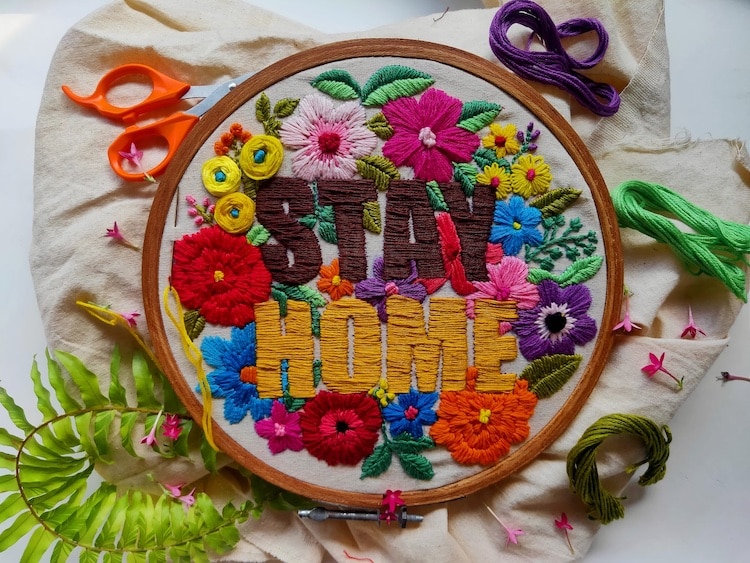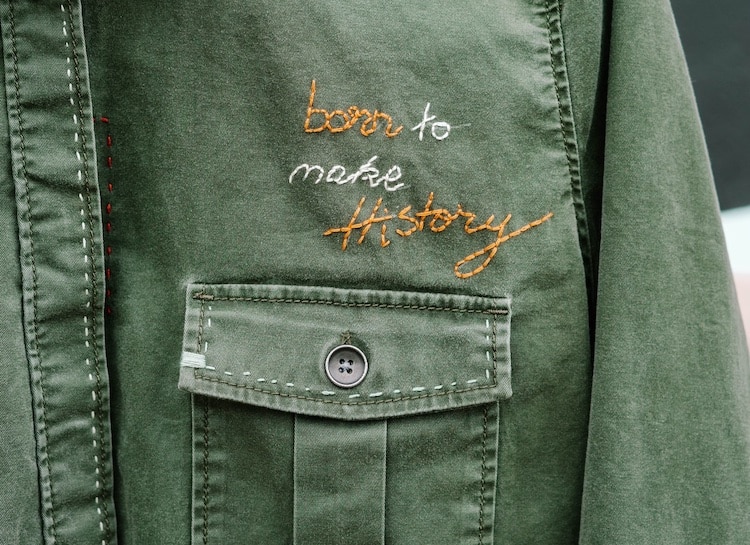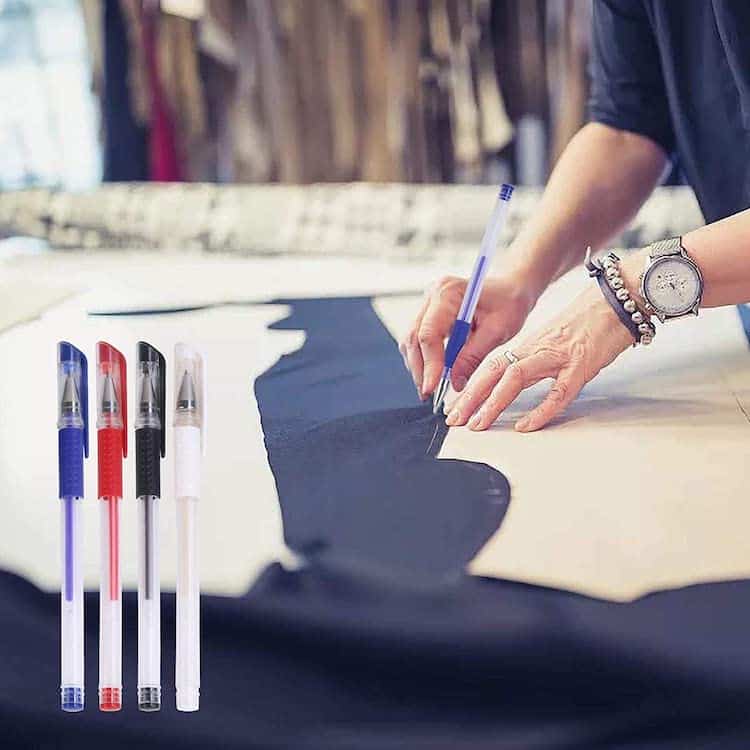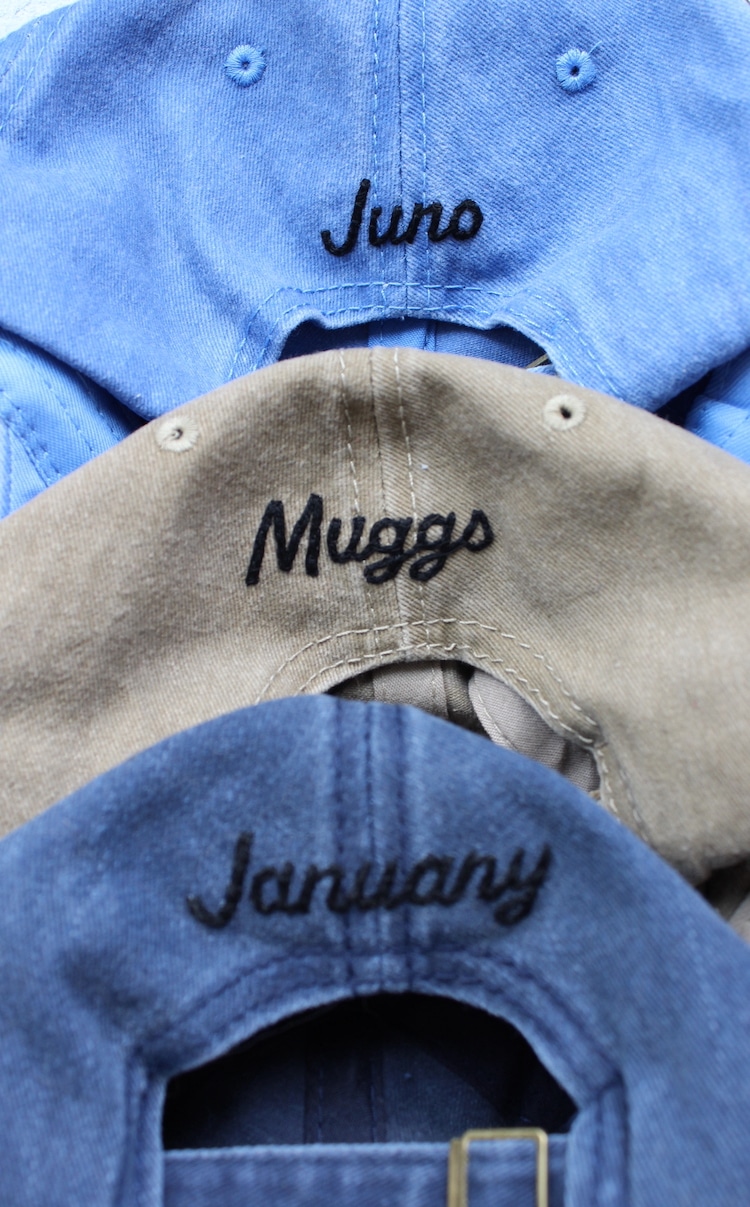
Photo: Swati H. Das
This post may contain affiliate links. If you make a purchase, My Modern Met may earn an affiliate commission. Please read our disclosure for more info.
One of the best skills to have as an embroiderer is an ability to stitch letters. In being able to embroider letterforms, you can personalize a project or open up your imagery to include quotes or other letter-focused work. If you’ve ever wanted to try monograms, this is the perfect opportunity.
It might seem like a challenge to embroider letters. The good news is that if you know some basic stitches, you already know how to embroider them. That’s right—you don’t have to have any additional skills to sew a letter. You just need a nice-looking name or phrase to stitch.
Embroidering letters is easily accessible for the beginner, but there are still some things you’ll want to know to make sure that your work looks its best. We’ll cover tips for making sure that your lettering looks great and the most popular lettering stitches (along with how to do them).
Tips for Embroidering Letters

Photo: Toa Heftiba
How to always have nice-looking lettering on your embroidery.
There are two components to embroidering letters: eye-pleasing lettering and well-executed stitching. The embroidering part will take practice, but regardless of your skill level, you can ensure that your letter will always look nice. It’s as simple as first formatting it on your computer.
Laying out your typography on the computer—using a program like Adobe Illustrator, InDesign, or even Photoshop—will allow you to tweak everything about your design. You can adjust the font size, kerning (space between the letters), tracking (space between groups of letters), and leading (vertical spacing between lines of type) to make it look exactly how you want.
Formatting your typography on the computer before you stitch will also allow you to play with fonts that will best suit your project. To see the possibilities, check out the selection on Google Fonts. It’s an open-source library with 1,482 font families that you can download to your computer. Take advantage of their search filter to find something that will work for you.
Once you’ve got your font selected and designed, you’ve now got to get it from your computer screen onto your fabric. There are a couple of ways to do that: using a lightbox or printing on wash-away stabilizer.
How to transfer an embroidery pattern on fabric.
There are multiple ways to transfer an embroidery pattern onto your fabric. Here are two common approaches: one that uses a pen and the other that uses a special material called wash-away stabilizer. Both will accurately transfer your text, so select the method that appeals to you. There is a caveat, however—you must have access to a printer to print your text.

Janyun | $8.99
Transfer your design with a lightbox (or sunny window) and pen. Of the two approaches discussed here, transferring a design with a pen is likely the most accessible. All that is required (beyond the printer) is a pen and a light box or sunny window. To transfer, place your printed text under the fabric up to the source of light. You should be able to see the text. Then, use your pen to trace it onto the fabric.
As far as utensils are concerned, a ballpoint pen is a popular choice. But for folks who transfer a lot of embroidery patterns and want the option to erase an errant line, heat-erasing pens are beloved by crafters.

Sulky | $14.14
Transfer your design using a wash-away stabilizer. Sometimes, it’s too difficult to transfer a design using a pen. It could be because the fabric is too thick, you’re wanting to stitch a design onto dark cloth, or you want to put your design on a hat. These are all reasons to use wash-away stabilizer, also called stick and stitch stabilizer.
Stick and stitch stabilizer is meant to fit in your printer. Once inserted, you’ll simply print your design like you would any sheet of paper. Then, cut around the image and peel it from the stabilizer backing. Stick it onto your fabric. You can then start stitching as you normally would. When done, rinse the design under warm water to wash it away.
Best Stitches for Embroidering Letters
In the realm of embroidery stitches, there is a lot to choose from, and many of them work well for lettering. Outline stitches, in particular, are tailor-made for a lot of embroidered typography because essentially, that’s what you’re doing—outlining letters. But there are some stitches that are easier to incorporate into text than others. Each is considered a basic stitch and easy to learn. Need help getting started? Check out these tutorials below.
Back Stitch
View this post on Instagram
The backstitch is the easiest stitch out of this bunch. It’s made by inserting your needle and working backward with each stitch forward.
Begin by bringing your needle up through your fabric and taking it one stitch length forward, bringing it through the cloth to the back. On the backside, take your needle one stitch length forward and bring it to the front of the fabric. You’ll have one stitch-length size space between your first stitch and the one you just made. Take your needle backward to meet the point where your first stitched ended and insert the needle into the hole. Repeat the process.
Split Stitch
View this post on Instagram
The split stitch is another outline stitch that looks like a chain. (Not to be confused with the chain stitch, also on this list.) Start the stitch by going a stitch length forward. Your needle will now be on the backside of your fabric. Then, work backward—just a little, and bring your needle up through the stitch just made, splitting it. Once you’ve split the stitch, move a stitch length forward as you normally would.
When using this stitch, make sure you’re using an even number of threads in your needle because you will be splitting the embroidery floss as you do it.
Satin Stitch

Photo: Sara Barnes / My Modern Met
The satin stitch is a filling stitch that’s best for thicker letterforms or if you’re trying to mimic letters stitched on an embroidery machine. Begin by bringing up the needle from the back of your fabric to the front. Then, insert the needle at a point opposite your original entry (such as the other side of the letterform) and pull it through to the backside. On the back of the fabric, pick a point that’s opposite to where you just pulled your needle through; make sure this is not the same hole you just made. Bring the needle up through your fabric until you’ve filled the area with satin stitches.
Chain Stitch
View this post on Instagram
The chain stitch is exactly what it sounds like; the end result looks like the links of a chain. Start by bringing your needle up through your fabric and then down again in the same hole. Don’t take your thread all the way down into the hole; leave a loop of thread on the surface. Then, with your needle on the backside, move a stitch length either right or left (depending on your dominant hand) and bring it up through the fabric, going through that loop you just made. Pull your thread and you should have the first link in your chain. Repeat the process.
This is likely the most popular stitch for hand-embroidered letters as it’s easy to replicate while creating an eye-pleasing texture.
Couching Stitch
View this post on Instagram
The couching stitch is great for stitching curves which will make navigating cursive fonts (and their inevitable loops) easier to do. This stitch uses two threads: your laid thread and your working thread. Your laid thread, as it suggests, will simply lay across your fabric while the working thread will be the string that tacks it down. Start by placing your laid thread in the shape that you want it. Then, bring your working thread up through the fabric on one side of the laid thread. Go over the laid thread and straight over to the other side. It will look like a little dot over the laid thread. Complete this until you’ve made it to the end of the string.
Related Articles:
29 Hand Embroidery Patterns Ready to Download and Start Sewing
Ultimate Guide to Embroidery: How It Started and How You Can Get Started Today
How to Customize Your Favorite Cap by Decorating It With Embroidery
